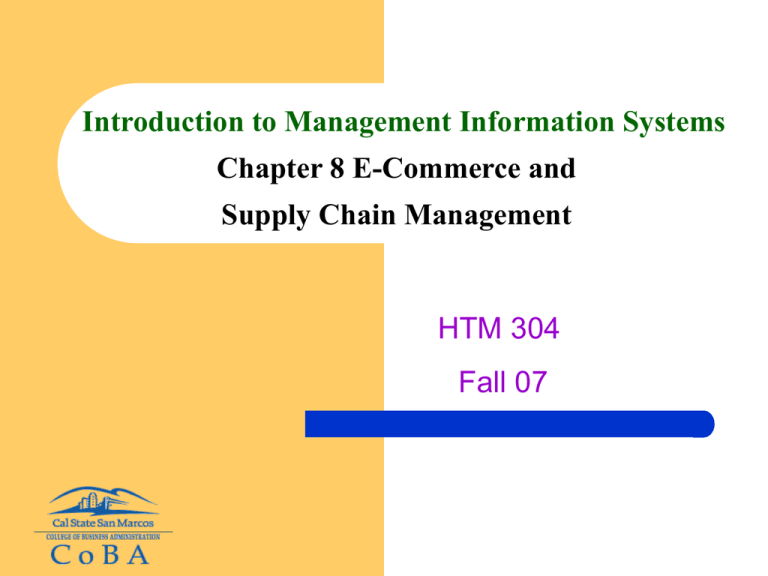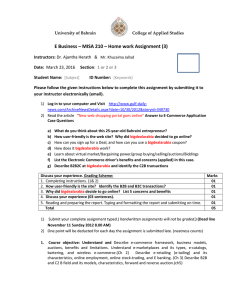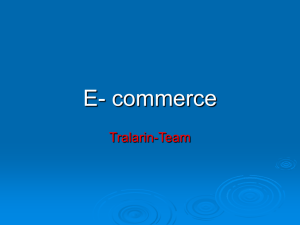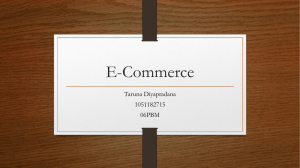Mac: new
advertisement

Introduction to Management Information Systems Chapter 8 E-Commerce and Supply Chain Management HTM 304 Fall 07 E-Commerce Concept: “Buying and selling goods and services over public and/or private computer networks” ? Reading news from yahoo.com is not e-commerce! ? Pay for subscription to WSJ.com is e-commerce! 2 Two types of E-Commerce companies US Census Bureau defines two types of e-commerce companies Merchant companies 3 Nonmerchant companies (Those who take title to the goods they sell. They buy & resell goods) (Those that arrange for the purchase and sale of goods without owning or taking titles.) – Business-to-consumer (B2C) – Auctions – Business-to-business (B2B) – Clearinghouses – Business-to-government(B2G) – Exchanges E-Commerce Merchant Companies Three major types (usually involves different procedures) -- B2C, sell directly to consumers web storefront for customers to arrange and place order -- B2B, sell to companies sales between companies, wholesales, bargained prices, etc. usually provide special portal. -- B2G, sell to government some say it is a variation of B2B; generally involves 4 different procedures, such as reverse auction. B2B example: OfficeMax sells to CSUSM Special group id/password Used to order item for organization Tailored catalog (may or may not be the best price, depending on the bargaining power) Special delivery process Generally ties in with the sellers’ CRM system 5 3 types overview in a Supply Chain structure B2C, first application and created huge buzz. relatively easy to create and manage. B2B and B2G: great potential but not fully understood. could involve significant business process redesign and system revolution The development and progress may be observed during your career 6 Nonmerchant E-commerce E-commerce auctions Clearinghouses buyer names the price seller names the price Enables auction company to offer goods for sale Arrange for delivery of goods but don’t take title Supports competitive bidding process Creates many new research issues (e.g. id management, multiauctions, shill-biddings, buy-it-now, etc.) 7 Electronic Exchange bid-ask prices (double auction) Match orders (similar to stock market) Major Types of Auction Mechanisms English Auction A.K.A. “first price open auction”, “open out-cry auction” The bidder continuously raise their bids. The highest bidder wins and pays his bid (the highest bid = the first price) What do you know about the highest bid? In theory, the first price = second highest bidder’s willingness-to-pay. How much is the first bidder willing to pay? Higher, never know the exact amount. Vickery Auction – designed by William Vickery, Nobel price winner All the bidders write down their evaluation and submit it in a sealed envelope. The highest bidder wins but pay the second highest bid (second price) All rational bidder’s best strategy is to write down their TRUE evaluation eBay’s current agent bidding mechanism is a variation. Dutch Auction Starts with a high asking price, which is gradually lowered. The bidder decides when to buy it. 8 Issues in Auction Auctions are good for price discovery Good for selling unique, non-standardized products improve efficiency. Competition is more intense bring in extra excitement, sometimes help increase the price Winner’s curse may prevent bidders telling the truth A phenomenon that the winner ends up paying too high: your winning means you paid more than others want to pay, also means you may not sell higher in resale. English Auction yields the highest winner’s curse. 9 Issues in Online Auction Internet brings more bidders together, good for the seller to find the best price However, many similar auctions going on simultaneously, distracts buyers Main research issues: Last minute bidders Shill-bidding Trust issue: “how do you trust someone you’ve never met?” Escrow service: www.escrow.com Reputation Systems: How it works? Potential issues? 10 E-Commerce: business/technology E-commerce improves market efficiency Disintermediation change of supply chain structure Flow of price information: Customers compare prices and rate vendors Vendors’ better sales strategy: Losing-bidder auction prices Price experimentation More accurate information of customer preference 11 Economic issues in E-Commerce Four major issues: Channel Conflict Price conflict Logistics expense Customer service expense 12 3-Tier Web Storefront Architecture 13 Three Tier Architecture “Tier” – class of computers: Three different classes of computers are involved in a typical estorefront application: User Tier: Hardware: user computers (low hardware requirements) Software: web browser (IE, Firefox, etc.) + others (flash player, etc.) Server Tier: Hardware: web Farm = web server computers (speed + reliability) Software: Apache server, IIS, Web applications (HTM 484G web programming) Database Tier: Hardware: DBMS computers (strong reliability/storage requirements) 14 Software: Database Systems Applications (HTM 411 Database) Info Flow: Typical Steps of Online Shopping Step 1: type in the web address of the store in your web browser. Protocol: http. Used to transfer webpages over Internet (app. layer) Request a webpage from Amazon.com web server. Language used to interact between user-tier computer and web server: 15 HTML: HyperText Markup Language Step 2: Get response from the web server, obtaining the webpage. Normally, one company will have multiple web servers to better respond the customers. Servers sometimes are located in different cities. Why? Receives your request and send you the webpage. Sometimes run applications to track your activity (e.g. clicks and mouse movements, the time spanned browsing, etc…) 16 Step 3: Search for the product. Requests are sent through the web server to the database. Database receives “query” and “report” requests and send corresponding result to the web servers. Web Server(s) run applications to display the search result to the viewer on the user-tier browser 17 Step 4: Click to view the details of the product. -- call for another query in the database to display the details. (SQL language: Structured Query Language) -- “add to shopping cart” and check out -> call for web applications to generate an order. 18 Each product is not a unique web page! All are the same page defining the display and calling the relative record from the database to display. Step 5: If you haven’t signed in yet, you will see this page when you start checking out. 19 Exercise yourself: which tiers computers are involved in this process. Give a brief description. Step 6: Entering your personal information. Explain the process of this page. a) Search the database to find your stored information b) If you choose not to use the same info, you can enter new info 20 21 Step 7: Review order and place your order a) The transaction record will be written into the database. b) Multiple tables in the database will be updated. c) The web applications are tightly integrated with the database design (E-R modeling) Summary of E-Commerce Ability to identify whether an web activity is E-commerce Ability to identify the two types of e-commerce companies Merchant companies (3 major types of merchant companies: B2C, B2B, B2G) Nonmerchant companies (give example) Explain why E-commerce improves efficiency Describe the 3-tier architecture for a web storefront Names of the computers Identify interactions among the three tiers Name the major language used to interact 22 between two adjacent tiers (HTML and SQL)






